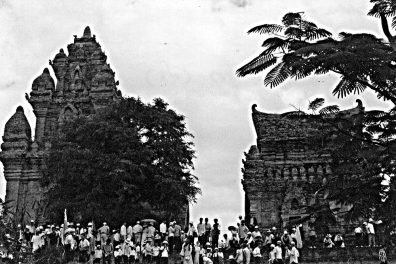Discovering the language
The Chame language (also written căm in scholarly transliteration) is an Austronesian speech of present-day Vietnam.
The Chams settled in central Vietnam around the Christian era. From this large country that stretched from the north of today's Quảng Bình province to the south of Phan Thiết, today only a community of less than 100,000 individuals remains, scattered across the present-day provinces of Ninh Thuận and Bình Thuận, as well as the province of Châu Ðốc, in the southwestern part of Vietnam.
Groups of Chams fled in successive waves to Cambodia from the XVth century. This population mingled with those of Malay origin, and now numbers over 200,000. A small proportion of these refugees went as far as Siam (now Thailand). A large number of Cambodian Chams (around 50,000) left Cambodia in 1975 and took refuge in the Malaysian state of Kelantan.
In the present day, the Chams of Vietnam and Cambodia can still speak their language, but it is mainly the Vietnamese Chams who still know how to write and can read their literature. Very few Cambodians still know their traditional script. The Chams alphabet originated in India and appears in inscriptions around the Vth century CE. It is used for inscriptions in both sanskrit and Chame languages. Inscribed texts can be found up to the XIIIth century. They are written in ancient Cham.
Today's Chams no longer know how to decipher the writing of ancient inscriptions. From the XVth century onwards, handwritten texts are written in Middle Cham and with a cursive script that differs greatly from that of the stone inscriptions. From the 19th century onwards, texts are written in modern Cham, and there is a romanized transliteration of Cham used by Western scholars. There are several types of writing, depending on the country in which the Chams wrote and the type of text (secular or sacred). The history of the Cham diaspora from the XVth century onwards has resulted in major differences between the speech of the Cham people of Vietnam and that of the Cham people of Cambodia. There are currently two Chams dialects. Grammatical rules are roughly the same, but there are notable differences in writing, pronunciation and vocabulary (with borrowings from Vietnamese on the one hand and Khmer on the other).
The Chame language belongs to the Austronesian fund, as do those of some of the minorities in the Highlands of Vietnam: jaraï, rhadé, raglaï, chru. These minorities were once part of Cham country. Ruins of Cham towers can still be found in Jarai country, and the Raglai are the custodians and guardians of the treasures of Cham kings.
